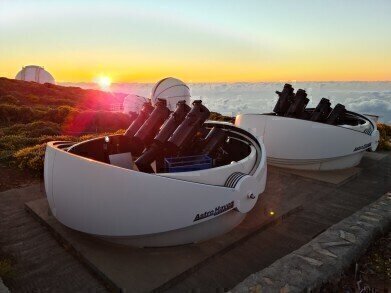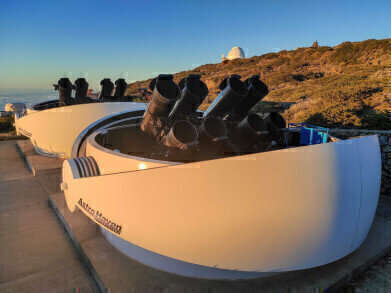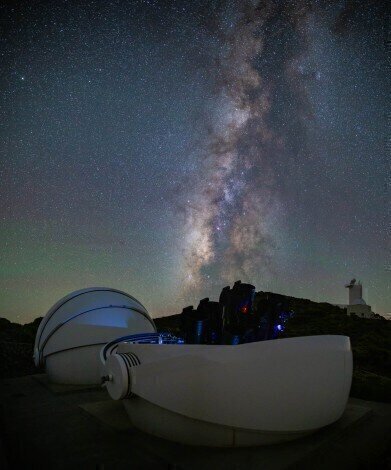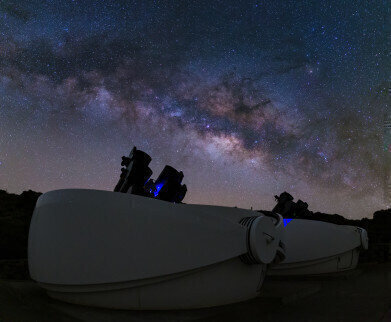-
 GOTO sunset Credit: University of Warwick
GOTO sunset Credit: University of Warwick -
 GOTO Twilight Credit: University of Warwick
GOTO Twilight Credit: University of Warwick -
 GOTO Milky Way Credit: University of Warwick
GOTO Milky Way Credit: University of Warwick -
 GOTO Milky Way Credit: University of Warwick
GOTO Milky Way Credit: University of Warwick
News
GOTO acts as intermediary for Gravitational Wave events
Oct 03 2022
Researchers in the UK and Australia are to track sources of gravitational waves using a new telescope deployed across two antipodal locations to fully cover the sky. Made up of two identical arrays, GOTO will scour the skies for optical clues about the violent cosmic events that create ripples in the fabric of space itself. The international project, which has received £3.2 million of funding from the Science and Technology Facilities Council (STFC) to deploy the full-scale facility, now has 10 partners, 6 of which are in the UK.
Long hypothesised as a by-product of the collision and merger of cosmic behemoths such as neutron stars and black holes, gravitational waves were finally detected directly by the Advanced LIGO (Laser Interferometry Gravitational-wave Observatory) in 2015.
GOTO has been designed to search for optical signals in the electromagnetic spectrum that might indicate the source of the GW – quickly locating the source of these fleeting signals and using that information to direct a fleet of telescopes, satellites and instruments at the source location.
Professor Danny Steeghs of the University of Warwick, GOTO’s Principle Investigator, said: “There are fleets of telescopes all over the world available to look towards the skies when gravitational waves are detected, in order to find out more about the source. But as the gravitational wave detectors are not able to pinpoint where the ripples come from, these telescopes do not know where to look.”
“If the gravitational wave observatories are the ears, picking up the sounds of the events, and the telescopes are the eyes, ready to view the event in all the wavelengths, then GOTO is the bit in the middle, telling the eyes where to look.”
Following the successful testing of a prototype system, an expanded, second generation instrument with two telescope mount systems, each with eight individual 40 cm (16 inch) telescopes, is now operational in La Palma, Canary Islands, Spain, covering a very large field of view with 800 million pixels across each telescopes digital sensors.
“The award of £3.2 million of STFC funding was critical in allowing us to build GOTO, as it was always envisaged to be; arrays of wide-field optical telescopes in at least two sites so that these could patrol and search the optical sky regularly and rapidly. This will allow GOTO to provide that much-needed link, to give the targets for bigger telescopes to point towards, “Professor Steeghs added.
In parallel, the team is preparing a site at Australia’s Siding Spring Observatory, which will contain the same two-mount, 16 telescope system as the La Palma installation, with plans for both sites to be operational ready for the next observing run of the LIGO/Virgo gravitational wave detectors in 2023. If astronomers can locate convincing counterparts to gravitational wave signals, it will be possible to measure distances, characterise the sources, study their evolution and determine the environments they are formed in.
Professor Steeghs added: "The hope is to catch the event quickly, then follow it as it fades, and also to trigger an alert to other, bigger telescopes so they can all collect more information and we can build a really detailed picture of these astronomical phenomena. It is a really dynamic and exciting time. In astronomy we are used to studying events which are millions of years old and aren’t going anywhere – this is a fast-paced, very different way of working where every minute counts.”
More information online
Digital Edition
Lab Asia Dec 2025
December 2025
Chromatography Articles- Cutting-edge sample preparation tools help laboratories to stay ahead of the curveMass Spectrometry & Spectroscopy Articles- Unlocking the complexity of metabolomics: Pushi...
View all digital editions
Events
Jan 21 2026 Tokyo, Japan
Jan 28 2026 Tokyo, Japan
Jan 29 2026 New Delhi, India
Feb 07 2026 Boston, MA, USA
Asia Pharma Expo/Asia Lab Expo
Feb 12 2026 Dhaka, Bangladesh


















